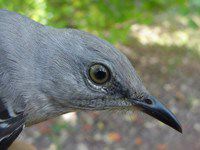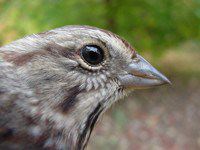|
|
|||
|
THIS WEEK at HILTON POND
15-21 October 2000 Installment #40--Visitor # Back to Preceding Week; on to Next Week |
|
SHARP-SHINNED HAWK When one October day there's a pile of feathers from a Swainson's Thrush, and two days later there's a headless Yellow-rumped Warbler in a mist net, the staff at Hilton Pond Center can be reasonably sure an accipiter has arrived in the neighborhood. 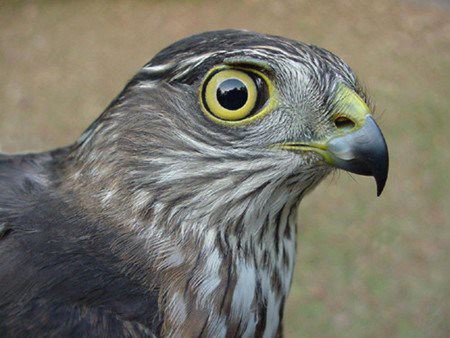
All text & photos © Hilton Pond Center That's exactly what happened this week, so it was no surprise to net an immature male Sharp-shinned Hawk, Accipiter striatus (above). Sharpies are the smallest of our accipiters--a family of hawks that include the Cooper's Hawk and Goshawk--all of which make their living chasing down and eating smaller birds. Accipiters are well-adapted for such work, with short, powerful wings that allow them to chase their prey through woods and thickets where larger raptors could not follow.
When an accipiter goes after prey, it may use its strongly hooked bill to kill, but it's typically the feet that do the dirty work. The long toes of a Sharp-shinned Hawk (below) are tipped with curved talons that are thin and incredibly sharp and easily capable of penetrating a songbird's internal organs. These claws are wondrous in their construction, and even a cursory look will explain why veteran hawk banders often carry scars from an in-the-hand encounter with an agitated sharp-shin. 
All text & photos © Hilton Pond Center NOTE: Be sure to scroll down for an account of all birds banded or recaptured during the week, as well as some other interesting nature notes. "This Week at Hilton Pond" is written and photographed by Bill Hilton Jr., executive director of Hilton Pond Center for Piedmont Natural History. You may wish to consult our Index of all nature topics covered since February 2000. You can also use the on-line Search Engine at the bottom of this page. For a free, non-fattening, on-line subscription to "This Week at Hilton Pond," just send us an E-mail with Subscribe in the subject line. Please be sure to configure your spam filter to accept E-mails from hiltonpond.org. |
|
Make direct donations on-line through
Network for Good: |
|
|
LIKE TO SHOP ON-LINE?
Donate a portion of your purchase price from 500 top on-line stores via iGive: |
|
|
Use your PayPal account to make direct donations:
|
|

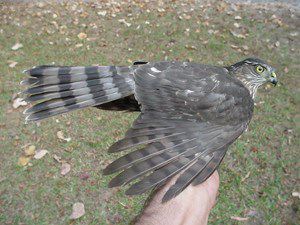 Young sharpies are mostly grayish-brown on back and wing (left), with dull-rust vertical streaking on their otherwise white breasts; the tail is noticeably barred, and the iris is yellow. As sharp-shins mature, the breast becomes marked with irregularly shaped, horizontal, rusty bars, and the wings and back take on a dark, gunmetal blue color. Most mature birds have blazing red eyes that may well strike fear in anything they gaze upon.
Young sharpies are mostly grayish-brown on back and wing (left), with dull-rust vertical streaking on their otherwise white breasts; the tail is noticeably barred, and the iris is yellow. As sharp-shins mature, the breast becomes marked with irregularly shaped, horizontal, rusty bars, and the wings and back take on a dark, gunmetal blue color. Most mature birds have blazing red eyes that may well strike fear in anything they gaze upon.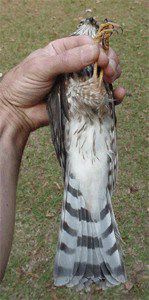 Sharp-shinned Hawks are so named because their long lower legs are unfeathered and surprisingly thin (right); most males take the same size band (#2) as a Brown Thrasher or Northern Mockingbird. The first-year male Sharp-shinned Hawk in the photo above is scarcely larger than a Blue Jay, and female sharp-shins are as much as one-third larger than males--typical of birds of prey, including owls and eagles. (Female sharpies get #3 bands.) Because of the size differential between sexes, it's likely that males and females have slightly different foraging habits and take different sizes of prey. A male sharpie, for example, would have no trouble capturing and killing a Swainson's Thrush, but it would probably take a large female sharp-shin to knock off a bird the size of a Common Grackle. By comparison, the much-bigger Goshawk can bring down birds as big as Common Crows and Ring-necked Pheasants.
Sharp-shinned Hawks are so named because their long lower legs are unfeathered and surprisingly thin (right); most males take the same size band (#2) as a Brown Thrasher or Northern Mockingbird. The first-year male Sharp-shinned Hawk in the photo above is scarcely larger than a Blue Jay, and female sharp-shins are as much as one-third larger than males--typical of birds of prey, including owls and eagles. (Female sharpies get #3 bands.) Because of the size differential between sexes, it's likely that males and females have slightly different foraging habits and take different sizes of prey. A male sharpie, for example, would have no trouble capturing and killing a Swainson's Thrush, but it would probably take a large female sharp-shin to knock off a bird the size of a Common Grackle. By comparison, the much-bigger Goshawk can bring down birds as big as Common Crows and Ring-necked Pheasants.

